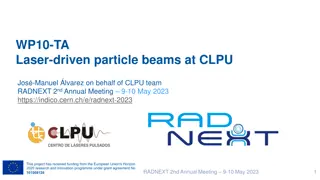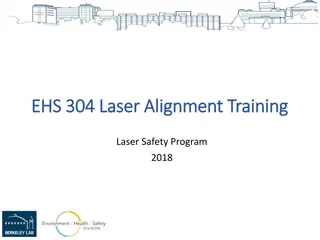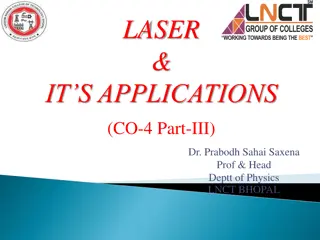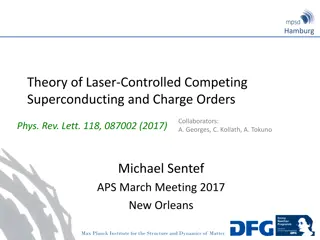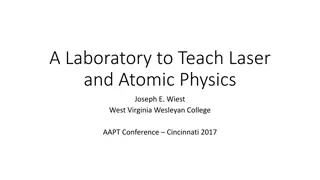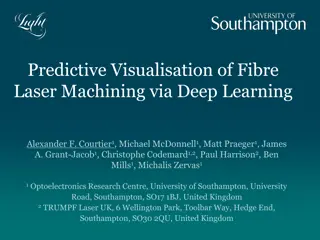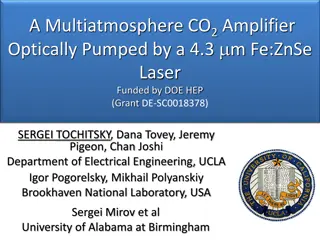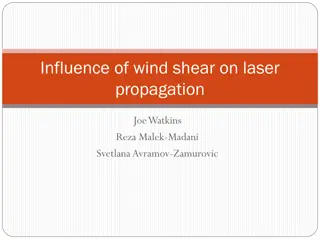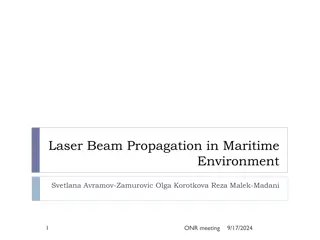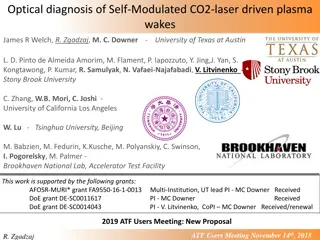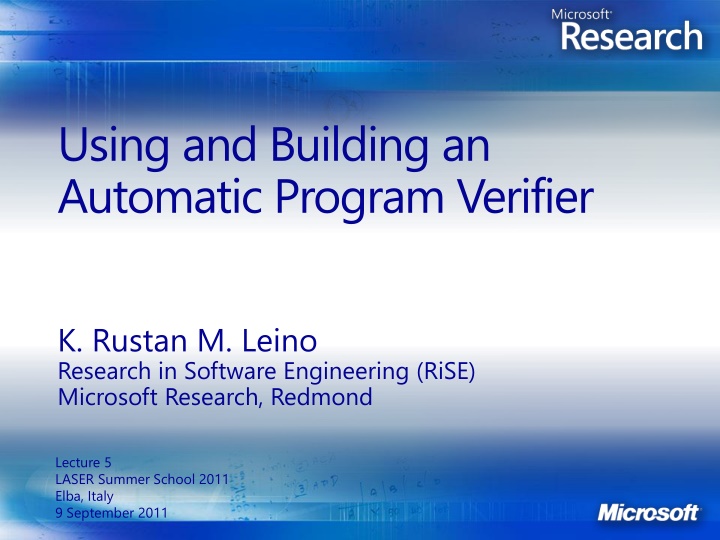
Automatic Program Verifier and Boogie Language Overview
This content explores the concepts of automatic program verification through Separation of Concerns, Intermediate Verification Language, and Boogie language overview. It delves into the verification architecture using tools like Boogie and SymDiff, emphasizing the importance of structured verification techniques. It also covers aspects of unstructured control flow and .NET bytecode, providing insights into verification methodologies and practical implementation strategies.
Download Presentation

Please find below an Image/Link to download the presentation.
The content on the website is provided AS IS for your information and personal use only. It may not be sold, licensed, or shared on other websites without obtaining consent from the author. If you encounter any issues during the download, it is possible that the publisher has removed the file from their server.
You are allowed to download the files provided on this website for personal or commercial use, subject to the condition that they are used lawfully. All files are the property of their respective owners.
The content on the website is provided AS IS for your information and personal use only. It may not be sold, licensed, or shared on other websites without obtaining consent from the author.
E N D
Presentation Transcript
Using and Building an Automatic Program Verifier K. Rustan M. Leino Research in Software Engineering (RiSE) Microsoft Research, Redmond Lecture 5 LASER Summer School 2011 Elba, Italy 9 September 2011
Separation of concerns Intermediate verification language Intermediate representation
Verification architecture Boogie
Verification architecture Boogie inference SymDiff
Boogie language overview Mathematical features type T const x function f axiom E Imperative features var y procedure P spec implementation P { body }
Boogie statements x := E a[i] := E havoc x assert E assume E ; call P() if while break label: goto A, B
Translation basics C Boogie var x: int; int x; procedure update(y: int) returns ($result: int) modifies x; { if (x < y) { x := y; } $result := y; } int update(int y) { if (x < y) x = y; return y; } void main() { update(5); } procedure main() modifies x; { call update(5); }
Unstructured control flow .NET bytecode (MSIL) Boogie var i: int, CS$4$000: bool; var $stack0i, $stack1i: int, $stack0b: bool; IL_0000: $stack0i := 0; i := 0; goto IL_000b; IL_0005: $stack1i := i; $stack0i := $stack0i + $stack1i; i := $stack0i; IL_000b: $stack0i := i; $stack1i := n; $stack0b := $stack0i < $stack1i; CS$4$000 := $stack0b; $stack0b := CS$4$000; if ($stack0b) { goto IL_0005; } IL_0013: return; .maxstack 2 .locals init ([0] int32 i, [1] bool CS$4$0000) IL_0000: nop IL_0001: ldc.i4.0 IL_0002: stloc.0 IL_0003: br.s IL_000b IL_0005: nop IL_0006: ldloc.0 IL_0007: ldc.i4.1 IL_0008: add IL_0009: stloc.0 IL_000a: nop IL_000b: ldloc.0 IL_000c: ldarg.0 IL_000d: clt IL_000f: stloc.1 IL_0010: ldloc.1 IL_0011: brtrue.s IL_0005 IL_0013: ret
Reasoning about loops Java + JML Boogie //@ requires 0 <= n; void m(int n) { int i = 0; //@ loop_invariant i <= n; while (i < n) { i++; } //@ assert i == n; } procedure m(n: int) requires 0 <= n; { var i: int; i := 0; while (i < n) invariant i <= n; { i := i + 1; } assert i == n; }
Exceptions Boogie type Outcome; const unique Normal: Outcome; const unique E: Outcome; Modula-3 exception E; procedure Q(x: integer) raises {E} = begin if x = 15 then raise E end; (* ... *) end Q; procedure Q(x: int) returns ($o: Outcome) { if (x == 15) { $o := E; goto L0; } // ... $o := Normal; L0: } procedure P(y: int) { var $o: Outcome; call $o := Q(y); if ($o == E) { goto L1; } // ... goto L2; L1: // exception handler L2: } procedure P(y: integer) = begin try Q(y); (* ... *) except E => (* exception handler *) end end P;
Custom operators: underspecification C++ Boogie const Two^31: int; axiom Two^31 == 2147483648; void P() { int x; x = y << z; x = y + z; } function LeftShift(int, int): int; axiom (forall a: int :: LeftShift(a, 0) == a); function Add(int, int): int; axiom (forall a, b: int :: -Two^31 <= a+b && a+b < Two^31 ==> Add(a,b) == a+b); procedure P() { var x: int; x := LeftShift(y, z); x := Add(y, z); }
Definedness of expressions F# Boogie let x = y + z in let w = y / z in // ... // check for underflow: assert -Two^31 <= y+z; // check for overflow: assert y+z < Two^31; x := y + z; // check division by zero: assert z != 0; w := Div(y, z);
Uninitialized variables Pascal Boogie var r: integer; if B then r := z; (* ... *) if C then begin d := r end var r: int; var r$defined: bool; if (B) { r, r$defined := z, true; } // ... if (C) { assert r$defined; d := r; }
Loop termination Eiffel Boogie from Init until B invariant Inv variant VF loop Body end Init; while (!B) invariant Inv; // check boundedness: invariant 0 <= VF; { tmp := VF; Body; // check decrement: assert VF < tmp; }
Modeling memory C# Boogie type Ref; const null: Ref; class C { C next; void M(C c) { C x = next; c.next = c; } } type Field; const unique C.next: Field; var Heap: [Ref,Field]Ref; // Ref * Field --> Ref procedure C.M(this: Ref, c: Ref) requires this != null; modifies Heap; { var x: Ref; assert this != null; x := Heap[this, C.next]; assert c != null; Heap[c, C.next] := y; }
More about memory models Encoding a good memory model requires more effort Boogie provides many useful features Polymorphic map types Partial commands (assume statements) Free pre- and postconditions where clauses
Boogie FindZero translated
Exercises C Gauss into Boogie http://rise4fun.com/Boogie/AEp Java swap http://rise4fun.com/Boogie/kU FindZero translation errors http://rise4fun.com/Boogie/E01
Quantifiers Instantiation via e-graph matching A matching pattern (trigger) is a set of terms that together mention all the bound variables, and none of which is just a bound variable by itself Examples: ( x { f(x) } 0 f(x)) ( x,y { g(x,y) } f(x) < g(x,y))
Trigger examples ( x,y { f(x), f(y) } x y f(x) f(y)) ( x { f(x) } x null f(x) f(next(x))) ( x { f(next(x)) } x null f(x) f(next(x))) ( x,y { f(x), f(y) } f(x) = f(y) x = y) ( x { f(x) } fInv(f(x)) = x) ( x { fInv(f(x)) } fInv(f(x)) = x) ( x { f(x+1) } f(x) f(x+1)) ( x,y,z { x*(y+z) } x*(y+z) = x*y + x*z) ( x,y { P(x,y) } x = y P(x,y) = 10) ( x { P(x,x) } P(x,x) = 10)
Future More inference Better specification constructs Improved user interface More aggressive and clever background proving Prioritize what to check next Suppress some complaints
Turn-around time Time to get a failed proof must be short (Time to re-run a proof does not matter)
Post-mortem verification Forward-looking design Timeline Ouch! Need specifications
More help during software design More expressive languages Refinement Synthesis
Take-home messages Program verification tools exist Use them to prove tricky algorithms Use them to learn reasoning concepts Use them in teaching Extend them To build a verifier, use an intermediate verification language (IVL) An IVL is a thinking tool IVL lets you reuse and share infrastructure
Links Dafny research.microsoft.com/dafny rise4fun.com/Dafny/tutorial/guide Boogie boogie.codeplex.com rise4fun rise4fun.com Verification Corner research.microsoft.com/verificationcorner

